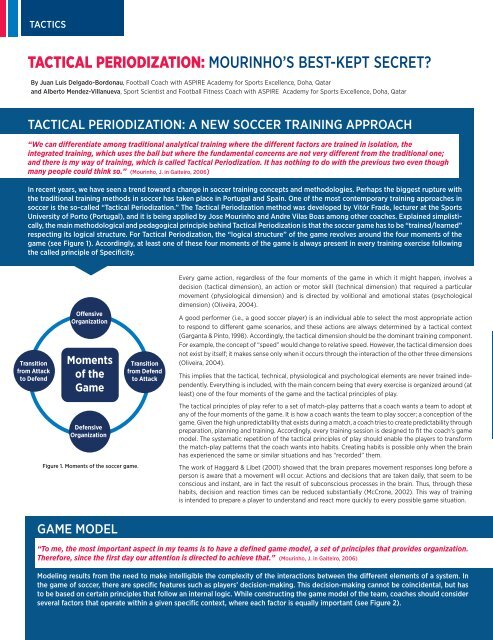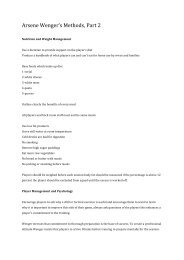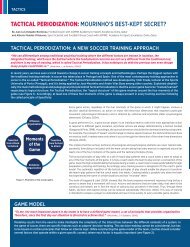Tactical Peroidization.pdf
- No tags were found...
Create successful ePaper yourself
Turn your PDF publications into a flip-book with our unique Google optimized e-Paper software.
A key aspect in building the game model relates to the idea of play that the coach wants to see. It is imperative<br />
that players know exactly what they have to do in every moment of the game. A coach will want certain<br />
Tactics<br />
tactical behaviors and patterns to be revealed during the game.<br />
Principles &<br />
Sub-principles<br />
of Play<br />
Coach’s<br />
Ideas<br />
Structural<br />
Organization<br />
Players’<br />
Capabilities<br />
Game<br />
Model<br />
Moments of<br />
the Game<br />
Club’s<br />
Structure &<br />
Aims<br />
Club &<br />
Country<br />
Football<br />
Culture<br />
Figure 2. Factors that influence in designing and<br />
building up a game model.<br />
(Adapted from Oliveira, G. 2007)<br />
Thus, the model consists of principles, sub-principles, and sub-sub-principles of play that represent different<br />
moments of the game (Oliveira, 2003).<br />
The compatibility of the different principles and moments of the game is particularly important, because<br />
behaviors sometimes can be incompatible. These behaviors and patterns will express a collective dynamic<br />
behavior, revealing a certain playing identity, which could be called a functional organization. The structural<br />
organization is how the team is placed on the field; it is usually called system of play, for example 1-5-3-2 or<br />
1-4-3-3. Although the structure represents only a fixed spatial shape, it can have an important role in promoting<br />
or constraining the desired behaviors. For instance, to have good levels of ball possession and circulation,<br />
players create diagonals and “diamonds.” Some structural organizations can enhance these behaviors more<br />
than others (e.g., structures with a high number of lines, both transversal and longitudinal).<br />
Regarding players, the game model has to highlight and enhance their best features and capabilities. It is essential<br />
that the coach develop a deep knowledge of the players, especially their level of game understanding.<br />
In this regard, Frade (2003) points out that the game “has to be born first in the players’ minds.” Therefore,<br />
it is crucial for the coach to use strategies to let the players recognize the importance of certain behaviors.<br />
Consequently, the construction of the game model arises through a process that operates among the coach,<br />
players and the team itself. The coach’s constant awareness about what should happen both in collective<br />
and individual terms and what is actually happening in the game should be the driver of the training process.<br />
However, it is important to understand that the definition and creation of a clear game model should not<br />
be perceived as something that will require players to act as “robots” following a predefined plan. On the<br />
contrary, the main purpose of having a clear game model is to reduce players’ uncertainty, which should give<br />
players more time to use their creativity.<br />
The structure and expectations of a club or federation are also an important aspect in creating a game<br />
model. Coaching a team that can train only two or three times a week is different from coaching one that<br />
can practiced five days. The scope for improvement both collectively and individually is also different. The<br />
culture of the countries and clubs has to be considered when creating a game model.<br />
<strong>Tactical</strong> Periodization:<br />
methodological<br />
principles<br />
The <strong>Tactical</strong> Periodization has defined and developed unique<br />
methodological (pedagogical) principles.<br />
<strong>Tactical</strong><br />
Fatigue &<br />
Concentration<br />
Hierarchy<br />
Organization<br />
Performance<br />
Stabilization<br />
<strong>Tactical</strong><br />
Periodization<br />
Methodological<br />
Principles<br />
Horizontal<br />
Alternation<br />
Making<br />
Principles<br />
Operational<br />
Systematic<br />
Repetition<br />
Complex<br />
Progression<br />
Figure 3. Methodological principles of the <strong>Tactical</strong> Periodization.<br />
Principle of specificity<br />
“For me training means to train in specificity. That is, to create exercises that allow me to exacerbate my principles of play.”<br />
(Mourinho, in Amieiro et al, 2006)<br />
This may be the most important principle of <strong>Tactical</strong> Periodization. Specificity arises when there is a permanent relationship between<br />
all the dimensions of the game and the training exercises are specifically representative of the game model (style of play).<br />
Therefore, the concept of Specificity directs and leads the training process. In this regard, Vitor Frade (in Silva, 1998), affirms that<br />
regardless of the training exercises’ features (e.g., with more or fewer players, larger or smaller spaces), they should always be<br />
articulated in a way that enables our principles of play to be learned and used in competition. But every exercise is just “potentially<br />
specific.” The fulfillment of the Principle of Specificity will be achieved only if during training players understand the aims<br />
and objectives of the exercise, they maintain high levels of concentration, and the coach’s intervention is appropriated (Oliveira,<br />
2008). Then, specificity is related to the capacity to make operational the principles of play, and their respective sub-principles.<br />
Continued on page 31<br />
29
Principle of making tactical principles of play operational<br />
“One of the most difficult questions is to make operational our style of play that by creating exercises where we are able<br />
to embrace all aspects (dimensions), but never forgetting our first concern: to enhance a given principle of play of our<br />
game model.” ( (Mourinho, J. in Gaiteiro, 2006)<br />
A team tends to be attracted to a dynamic behavior that represents its identity and describes a pattern of action. To transform these<br />
patterns into practice, every training exercise must relate to the style of play (game model) and the concept of specificity (see above).<br />
These references should be present in daily work, in order to provide specific adaptations and tactical knowledge. If the proposed<br />
exercise is designed without taking into consideration the style of play, the promoted adaptations can have adverse effects and interfere<br />
with acquisition of the desired knowledge. It is crucial that the exercises represent the way we want to play and the randomness<br />
and unpredictability that the game has. This implies that each of the proposed exercises has to lead to something that players do not<br />
control. If the game is nonlinear, the training exercises, even being less complex, should be nonlinear, excluding any direct cause-effect<br />
relationship. The coach’s intervention plays a key role in conducting the exercise, catalyzing in a positive or negative way its specificity.<br />
It is also important to note that the structural and functional configuration of the exercises is crucial in order to comply with the specificity<br />
of the game. It means that some exercises, because of their structure, promote functionality (e.g., the acquisition of non-conscious<br />
behaviors).<br />
Principle of disassembly and hierarchical organization<br />
of principles of play<br />
“I wrote a document that never is going to be published. It is my training dossier, where I keep all my training guidelines. That<br />
is, all my training goals and the way to achieve them through my methodological principles; ‘to improve these given principles,<br />
these exercises.’ If I should have to name this document, its title would be: ‘The evolution of my training concepts.’<br />
(Mourinho, J. in Lourenço, L. & Ilharco, 2007)<br />
Sub -Sub<br />
Principle:<br />
Changing mental<br />
attitude from attack<br />
to defend<br />
Moment of the Game<br />
Transition from Attack to Defend<br />
Main Principle:<br />
Immediate press to opponent<br />
on the ball and his nearest space<br />
Sub-Principle:<br />
Making the opponent<br />
to play backwards<br />
Figure 4. Example of the Disassemble of a Principle of Play.<br />
(Adapted from Gomes, M. (2006)<br />
Sub-Principle:<br />
Getting compact to<br />
either press the ball or<br />
to get organized to defend<br />
Sub -Sub<br />
Principle:<br />
Communication to<br />
ensure optimal<br />
defensive coverage<br />
Principles of play are complex concepts because they<br />
involve several variables that are related. This is why<br />
<strong>Tactical</strong> Periodization breaks them down to reduce their<br />
complexity. Thus, principles of play are subdivided into<br />
sub-principles, and these are further fragmented into<br />
sub-sub principles. The aim is to make them more understandable<br />
for the players. This process of disassembling<br />
the principles of play has to be done carefully, respecting<br />
the style of play (game model) and the wholeness of<br />
the game (systemic vision). Each specific principle of<br />
the game model is directly related to one of the four<br />
moments of the game (see Figure 4 for an example).<br />
Not an equal value is given to all the principles of play.<br />
Thus, there is a hierarchical organization. The importance<br />
of each principle during the training process is directly<br />
related to the intended game model. Some principles<br />
are more important and valued than others in terms<br />
of what is intended. A coach’s ability to articulate all<br />
the principles that conform to a game model will help<br />
determine the team’s DNA, the coach’s conception of<br />
the game (Tamarit, 2007).<br />
Continued on page 32<br />
31
Principle of horizontal alternation in specificity<br />
“Our daily concerns are directed to make operational our game model. However, the structure of the training session and<br />
what to do each day is related not only to tactical objectives, but also with the physical fitness component to be privileged.”<br />
(Mourinho, in Amieiro et al., 2006)<br />
This principle relates to the necessity of maintaining a regular<br />
and fixed weekly pattern respecting the alternation in<br />
the training-recovery demands (Amieiro et al., 2006). The<br />
Principle of Horizontal Alternation in Specificity highlights<br />
the importance and relevance that <strong>Tactical</strong> Periodization<br />
gives to the physiological dimension, contrary to the unfounded<br />
misconception that this dimension is forgotten<br />
and not trained. In a simplistic manner, the three main<br />
training (acquisition) days (see Figure 5) in the week will<br />
alternate the physical fitness component (we are here<br />
assuming that the team is playing one game per week).<br />
This is done by either prioritizing strength (first acquisition<br />
day), endurance (second acquisition day) and speed<br />
(third acquisition day) factors. Thus, no two days within<br />
a given week are demanding the same physical fitness<br />
component. The main goal is to avoid a large amount of<br />
the same physical fitness component stressed the day before,<br />
giving the body time to recover. Recovery would take<br />
place, at least partly, by switching the dominant physical<br />
fitness component throughout the week. This alternation<br />
in the physical fitness components to be prioritized is said<br />
to occur horizontally along the weekly pattern rather than<br />
Game<br />
Recovery<br />
Recovery<br />
Strength<br />
Aquisition Days<br />
Figure 5. Standard weekly pattern.<br />
(Adapted from Oliveira, 2007)<br />
between exercises within the same training session (vertically). The tactical goals of each training<br />
day may vary in accordance with the specific needs of the team, but the physical fitness<br />
component used on a given day of the week will remain the same. Thus, it can be said that for<br />
<strong>Tactical</strong> Periodization, the physiological dimension provides the biological framework where<br />
the soccer-specific training/recovery continuum lies.<br />
Endurance<br />
Speed<br />
Recovery<br />
Activation<br />
Game<br />
Principle of conditioned practices<br />
“Training is worth it only when it lets you make your ideas and principles operational. Thus, the coach has to find<br />
exercises to guide his team to do what it is intended to do in the game.” (Mourinho, J. in Gaiteiro, 2006)<br />
Type of physical<br />
Level of Intermittency<br />
(work recovery rate)<br />
Principle of<br />
Conditioned Practices<br />
Physiological<br />
Dimension<br />
<strong>Tactical</strong>/Technical<br />
Dimension<br />
Figure 6. Principle of conditioned practices.<br />
Density of<br />
predominant<br />
motor behaviors<br />
When the aim is to teach or improve a particular principle or<br />
sub-principle of a game model, the best way to do it is to create<br />
appropriate exercises. Then, if we are interested in certain<br />
behaviors related to a given principle of play, we should make<br />
them appear more often than others in the exercise. As such,<br />
the requested behavior has to appear more frequently than<br />
during the formal game, enabling players to create mental<br />
images about the desired target. Thus, the configuration of<br />
the exercise (e.g., playing space, number of players, rules,<br />
objectives) must promote the appearance of the required<br />
behaviors, what are called “conditioned practices” (see Figure<br />
6). For example, setting up an exercise where a team’s<br />
defensive sector is under-loaded and is constantly defending<br />
will make behaviors related to its defensive organization<br />
emerge. Then, there will be many opportunities for coaches<br />
and players to “shape” these behaviors.<br />
32 May | June 2012
Principle of complex progression<br />
“Since the very beginning, the principles and sub-principles of our game model are privileged through a set of exercises.<br />
But the best way to convey our ideas is by lowering the complexity through reduced games.” (Mourinho, J. in Fernandes, 2003)<br />
This principle relates to the hierarchical organization of the principles and sub-principles of play. It has nothing to do with a general to<br />
specific progression, from volume to intensity. For <strong>Tactical</strong> Periodization, the concept of progression is built around the acquisition of a<br />
certain way of playing. This progression appears at three different levels of complexity: during the season, throughout the week (taking<br />
into account the last game and the next one) and finally during each training session, thus becoming a complex progression where each<br />
level is related to the others.<br />
According to Frade (2004), at the early stages of the training season we should introduce the general principles of play (related to<br />
four moments of the game—defensive organization, offensive organization, transition defense-attack and transition attack-defense).<br />
If players know and can explain when to apply the principles of play relative to each moment, it will be easier for them to assimilate<br />
the specific principles that each coach has in a game model. In a second phase, we will work on the specific principles of “our” model<br />
of game. At this stage we can distinguish two moments. The first: the defensive organization of the team, which we will begin to work<br />
with. According to <strong>Tactical</strong> Periodization, it is preferred to focus first on defensive organization, because by having a good defensive<br />
balance the team will gain confidence and consistency, enabling coaches to progress into other game situations (defending properly to<br />
attack even better). In addition, to defend is “easier” than to attack. Then, coaches will move to more complex behaviors, such as the<br />
offensive organization. The transitions are key in soccer, so coaches should try to train them from the beginning. They will obviously be<br />
linked to the team’s defensive and offensive organization.<br />
To understand the entire logical structure, we should link the Principle of Complex Progression to the Principle of Horizontal Specificity<br />
Alternation. We refer to a “building up” and “disassembly” of the principles and sub-principles and their hierarchy inside the weekly<br />
plan and over weeks according to the evolution of the players and the team. This methodological principle has two levels of planning<br />
which interact with each other, the short-term (game to game) and medium- and long-term (style of play/game model).<br />
Principle of performance stabilization<br />
“I do not want my team to have peaks in performance. I do not want my team to swing performance. Rather than that, I prefer<br />
to keep always high levels of performance. This is because to me there aren’t periods or games more important than others.”<br />
(Mourinho, in Amieiro et al, 2006)<br />
Game<br />
Game<br />
Game<br />
Game<br />
Horizontal Alternation in Specificity<br />
Game<br />
Speed<br />
Speed<br />
Speed<br />
Speed<br />
Activation<br />
Recovery<br />
Strength<br />
Endurance<br />
Activation<br />
Activation<br />
Recovery<br />
Strength<br />
Endurance<br />
Activation<br />
Recovery<br />
Activation<br />
Recovery<br />
Recovery<br />
Strength<br />
Endurance<br />
Game<br />
Game<br />
Game<br />
Game<br />
Performance Stabilization<br />
The concept of performance from a conventional viewpoint is normally<br />
based on a set of quantitative- oriented criteria based essentially on<br />
the physiological dimension. Planning and periodization in soccer are<br />
vital to the concept of “performance stabilization,” derived from its<br />
long competitive period. From this perspective, “being fit” is to “play<br />
well.” And “play well” is to carry out the on-field duties in accordance<br />
with the game model that is intended. The basis of collective and<br />
individual performance is the organization of the team, which is the<br />
fundamental objective to be maintained. Thus, what really matters is<br />
that a team regularly demonstrates a quality of play (despite minor<br />
fluctuations) to guarantee regularity in the results.<br />
The stabilization of the level of optimum performance is achieved<br />
through the establishment and maintenance of the standard weekly<br />
plan (see Figure 7). Thus, over the season, a weekly dynamic regarding<br />
training contents, recovery schemes and the number and length of<br />
training units remain almost invariable. Soccer performance and training<br />
cannot be separated from the competition and the game. It must<br />
be translated in terms of play, a quality instead of quantity approach,<br />
working always on offensive and defensive actions and the dynamics,<br />
which allow the connection of these two moments. By working such<br />
way, the methodological Principle of Stabilization is respected.<br />
Continued on page 34<br />
Figure 7. Interaction between horizontal alternation and performance<br />
stabilization principles. (Adapted from Oliveira, G. 2007)<br />
33







